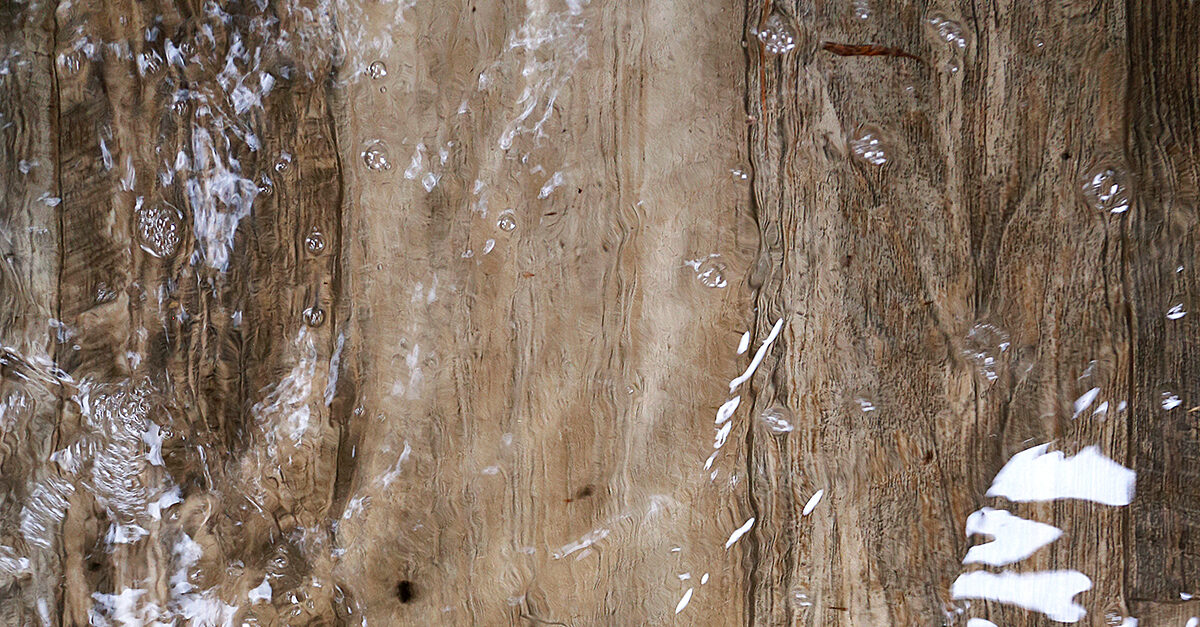If your facility resides within an area infamous for flooding—whether the cause be overflowing riverbanks, breached dams, atmospheric rivers, burst pipes, or hurricanes—its flooring needs the ability to sustain whatever nature can dish out.
But with so many flooring choices available, which is the right one? Read on to discover not only how to choose the correct flooring for a flood-prone facility, but how to choose one that fits the look, feel, and overall needs of your particular building.
What to avoid
Often, when trying to make a choice, eliminating what will not work is a good starting point. According to Chuck Boutall, director of education at the Restoration Technical Institute in Reading,
Pennsylvania—a nationally recognized training facility for the restoration industry—the main materials to avoid in floors at risk of flood and moisture damage are wood, lignin (an organic
polymer), cellulose, and latex.
“Any type of wood or wood composites, or any type of lignin or cellulose-based flooring, is going to be affected by the flood waters,” he said.
While carpet is not the best choice for a wet environment, a glued-down carpet is not necessarily bad, depending on the adhesive used, and can potentially be saved after a flood. According to Boutall, some facilities at higher risk for flooding might even choose an Astroturf-type carpeting.
What to consider
For a flood-prone facility, Boutall recommends the following three types of flooring.
Concrete
The best way to achieve a water-resistant flooring system is to have a finished concrete floor. With concrete, “typically, the worse thing you’ll have to
do is strip off your surface layer and repolish it,” Boutall said.
According to Jim Varnell, technical sales specialist at Curecrete Distribution—a manufacturer of supporting products for concrete application and enhancement located in Springville, Utah—the process of densifying concrete and cementitious terrazzo floors closes off the pores of the material and minimizes water absorption.
“A densified floor has low water absorption, high abrasion resistance, little or no mold growth, and can be easily repaired,” Varnell said. Facilities that use and could benefit from concrete floors
include schools, museums, stadiums, restaurants, hospitals, warehouses, stores, and transportation centers such as train stations and airports.
Another benefit of concrete is that it’s a low maintenance floor. “With a well-designed and implemented maintenance program, densified concrete can easily be maintained and kept at a
high functional level,” said Varnell.
However, concrete might not be the best fit for all facilities. “Some people don’t like the looks of it…and it’s also quite noisy, because it’s sound-reflective,” said Boutall. It’s also very important
that the top coat is applied correctly; otherwise, moisture from the underlying concrete can cause the coating to bubble as the moisture tries to rise into the air.
Varnell said that concrete—just like any hard-surface flooring—also runs the risk of becoming slippery when wet. And while it does tend to have an “industrial” look, Varnell added that
“densified-polished concrete can fit into upscale decor, because it can be colored and can offer varying degrees of aggregate exposure, from fine to large.”
Of course, the cost of adding a concrete flooring system will vary greatly based on the size of the facility, but most likely will be the least expensive of the three recommendations. According to
Varnell, “Large jobs will be less per square foot and smaller jobs will be more. In general, a densified floor [alone] will cost US$0.20 to $0.35 per square foot. Densified and polished concrete
[together] will cost between $2.00 to $3.50 per square foot. That includes both material and labor.”
Ceramic/Porcelain Tile
Next on Boutall’s list of recommendations is ceramic or, preferably in a commercial location, porcelain tile, due to its wear capability. However, you must be mindful of using the right types of
adhesives that won’t be affected by a flood.
“Some people today are using a latex-based adhesive, and depending on the type of latex and the mixture, there’s the potential for degradation of adhesion—basically, the tiles start popping off
the floor, or they can actually get mold in the grout lines,” he explained. “I recommend an epoxy-type grout, and make sure the adhesive is unaffected
by water.”
Ceramic and porcelain tiles can be both beautiful and extremely durable, Boutall said, but they will most likely be the most expensive of his recommendations.
Luxury Vinyl Tile
One of the newest materials that Boutall recommends is luxury vinyl tile (LVT). He said that at least one brand of LVT has been proven to be not only water-resistant, but waterproof. “A lot of the [manufacturers] like to use the word ‘water-resistant,’ which means if you spill a cup of water on it and wipe it up in 10 seconds with a towel, there’s not going to be a lot of effect on
the floor. That’s not a flooding event. So, there’s a huge difference between water-resistant and waterproof.”
Another advantage is that LVT is less sound-reflective and thus quieter than both cement and ceramic/porcelain flooring. It also can deliver good design aesthetics to a facility’s decor. It most likely won’t be as expensive as the ceramic/ porcelain flooring, but it probably will be more expensive than concrete.
An ounce of prevention
We all know the old saying, “An ounce of prevention is worth a pound of cure.” When it comes to a facility that is prone to flooding, what you’re aiming to prevent is the formation of fungi.
When flooring materials capture moisture, they allow fungi, typically in the form of mold, to reproduce. The presence of such pathogens creates a hazardous situation for your building’s
occupants, especially individuals who have lung illnesses or compromised immunity.
According to the U.S. Centers for Disease Control and Prevention (CDC), once mold begins to form, you must completely remove water-damaged articles, such as carpeting or affected
wood, from the premises to prevent the fungus from reproducing and causing harm to your building’s occupants. Continuously installing, removing, and replacing flooring is costly and inefficient. You can’t afford to leave it, but you might not be able to afford the expense of constantly replacing it either. So, any money saved by using a flooring susceptible to flood damage will only cost you more money in the long run.
But what if your building currently has flooring susceptible to flooding? According to Boutall, it doesn’t necessarily make sense to tear out such flooring before a flooding event occurs. “If it still
has plenty of service value left to it, I wouldn’t worry about getting rid of it,” he said. “It’s going to be removed after the flooding event, almost guaranteed,” not only because of the risk of mold
but also because flood water is characteristically contaminated with harmful pathogens.
However, after a flooding event occurs, you can then concentrate on selecting a flooring that will not be as susceptible to mold growth in future floods. A polished concrete floor would be a good
replacement at that time, as, according to Varnell, it’s minimally porous and, as such, does not have many places for mold—nor the nutrients that “feed” mold—to establish and grow.
Form follows function
While it might be tempting to look for a flooring that’s the most attractive and the least expensive, doing so while ignoring purpose and function can be a huge mistake.
Boutall, who also has been a commercial property owner throughout his career, noted that most fall prey to that line of thinking. “So many people use aesthetics as their first choice—and only choice—or, aesthetics and money,” when choosing flooring, he said. People think to themselves, “I want the best-looking and cheapest floor to be installed. That’s very pretty and
that’s very inexpensive, so let’s put it in.”
“But the biggest issue,” he continued, “is it’s not appropriate for that area.” If the floors get ruined quickly over time because they aren’t practical for the floor’s location and its use, the aesthetics and price that initially attracted the facility’s floor purchaser will just as quickly become moot points.
Instead, he said, “The most important thing, to combine practicality with attractiveness, is to make absolutely sure first that you have a floor that’s designed for the use of the floor.” You need to ask yourself questions about the floor’s traffic, usage, and chances of being in a flood to best determine its practically, and place that as a priority over aesthetics and price.
Dealing with damage
Flood prevention entails lowering the risk of flooding and the extent of the damage it might cause. It doesn’t assure that flooding will never occur, nor does it guarantee that there will never
be damage. It’s best to plan for the worst.
If a flooding event occurs, Boutall recommends that you first secure the safety of all your building’s occupants and visitors. If people don’t need to be in the building, keep them out.
Next, you’ll want to contact the person who acts as your risk manager and follow any corporate guidelines established for such events and losses. If you don’t have a risk manager, you might need
to call your insurance agency directly to report your event.
Lastly, you must perform “triage”—a preliminary assessment of the damage that has occurred. Boutall suggests doing so via a three-step process:
- Identify your high-cost materials and get them out of harm’s way immediately.
- Start extracting the water from the building by whatever means necessary. Contact a restoration company (ideally, there should already be a preferred vendor in your emergency plan) to mitigate and remove the flood water.
- Dry, clean, and/or remove the affected, contaminated materials.
“What we want to do is control the humidity very quickly,” he said, “so that the moisture from the floor does not move into the suspended ceiling and sag it.”
Immediate cleaning is also necessary after a flooding event involving concrete flooring. “Certainly, the polished concrete can be disinfected with normal disinfectants that attack mold,” Varnell said. “The floor might have a staining problem when bleach is used; however, it will not destroy the floor and can be repaired.”
The experts agree that its best to prepare well in advance of a flooding emergency by having an action plan already in place. Make sure the plan prioritizes the safety of your facility’s inhabitants and that you can quickly and effectively implement it if—or perhaps more likely, when—the time comes.




